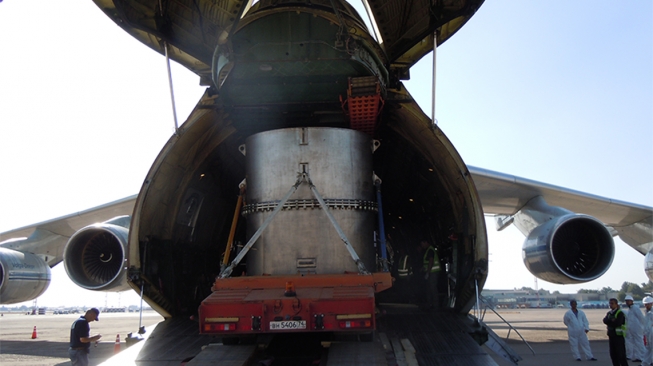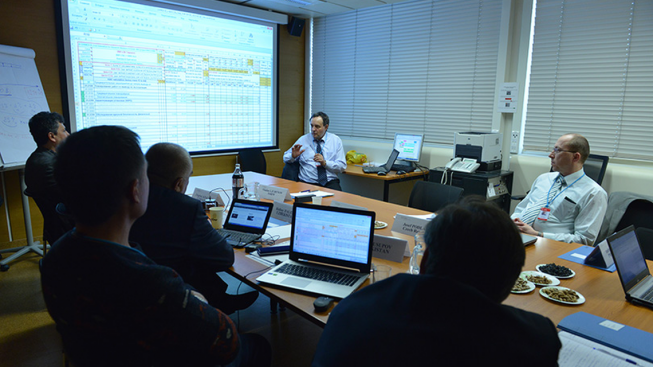No Small Fry: Decommissioning Research Reactors

On 24 September 2015, irradiated liquid highly enriched uranium
(HEU) fuel was removed from a research reactor at the Radiation and
Technological Complex in Tashkent, Uzbekistan and repatriated to Russia.
(Photo: S. Tozser/IAEA)
To get a permit to build a research reactor, would-be
operators need to submit an initial decommissioning plan for the
eventual shutdown of their new facility. This, however, was not a
requirement back in the 1950s, 60s and 70s when most research reactors
that are now nearing the end of their working lives were built. The
result: many unused reactors sit idle in the middle of university
campuses, research parks and hospital compounds, because their operators
lack the proper plans to decommission them.
“Our research reactor has recently received a licence to continue operations for at least a few more years, but we need to decide what we are going to do with it afterwards,” said Ketut Kamajaya, researcher in charge of the decommissioning of the Triga-2000 research reactor in Bandung, Indonesia.
There were 246 operational research reactors in 55 countries at the end of 2015, and over 180 that had been shut down or were undergoing decommissioning, according to the IAEA’s Nuclear Technology Review 2016. More than 300 research reactors and critical assemblies have been fully decommissioned. Around half of the operational research reactors are over 40 years old — making ageing management and decommissioning the key challenges for the research reactor community today.
Many countries do not have the institutional, legal and regulatory framework, expertise and technical infrastructure required for decommissioning, said Vladan Ljubenov, waste safety specialist at the IAEA. “Countries without a nuclear power programme typically have significantly less expertise in decommissioning and often lack the facilities to manage all but low level waste,” he said. While much of the decommissioning waste from a research reactor would indeed be low level waste, countries also need to deal with the small amounts of medium and high level waste generated.
Sometimes countries also lack the funds for decommissioning, even though in the long run they would save money by decommissioning facilities they can no longer use, said Vladimir Michal, Team Leader for Decommissioning and Environmental Remediation at the IAEA. Unless a research reactor has obtained a decommissioning license from its regulator, the safety and security regulations for operational reactors apply, even if the reactor is not in use and may not even have any fuel left. “Complying with regulatory requirements over time is more costly than biting the bullet and decommissioning,” Michal said. “It is better and safer to be under the decommissioning regime than in limbo.”
This is the approach Indonesia is taking, Kamajaya said. There are already plans in place to shift medical isotope production from Bandung to the country’s two other research reactor facilities. Training of scientists on reactor physics and thermal hydraulics will also move to the other locations. “Once we shut down the reactor, we will want to decommission it as soon as possible,” he said. In order to prepare for the shutdown, experts from the operators have participated in several IAEA technical cooperation projects, and have had the chance to witness ongoing decommissioning work in Australia and Belgium.
In Uzbekistan, the government decided to permanently shut down its research reactor at the Institute of Nuclear Physics in Tashkent in July 2016, and begin decommissioning as soon as feasible, said Umar Salikhbaev, Director of the Institute of Nuclear Physics. “We are working very closely with the IAEA on the preliminary decommissioning plan, which we want to submit to the government by May,” he said. This follows the decommissioning of the FOTON research reactor in Tashkent, which began last year and is scheduled to be completed by mid-2017. The reactor fuel was repatriated to Russia as part of a programme coordinated by the IAEA last September.
Old reactor, new reactor
“Our research reactor has recently received a licence to continue operations for at least a few more years, but we need to decide what we are going to do with it afterwards,” said Ketut Kamajaya, researcher in charge of the decommissioning of the Triga-2000 research reactor in Bandung, Indonesia.
Once we shut down the reactor, we will want to decommission it as soon as possible.180 to go
There were 246 operational research reactors in 55 countries at the end of 2015, and over 180 that had been shut down or were undergoing decommissioning, according to the IAEA’s Nuclear Technology Review 2016. More than 300 research reactors and critical assemblies have been fully decommissioned. Around half of the operational research reactors are over 40 years old — making ageing management and decommissioning the key challenges for the research reactor community today.
Many countries do not have the institutional, legal and regulatory framework, expertise and technical infrastructure required for decommissioning, said Vladan Ljubenov, waste safety specialist at the IAEA. “Countries without a nuclear power programme typically have significantly less expertise in decommissioning and often lack the facilities to manage all but low level waste,” he said. While much of the decommissioning waste from a research reactor would indeed be low level waste, countries also need to deal with the small amounts of medium and high level waste generated.
Sometimes countries also lack the funds for decommissioning, even though in the long run they would save money by decommissioning facilities they can no longer use, said Vladimir Michal, Team Leader for Decommissioning and Environmental Remediation at the IAEA. Unless a research reactor has obtained a decommissioning license from its regulator, the safety and security regulations for operational reactors apply, even if the reactor is not in use and may not even have any fuel left. “Complying with regulatory requirements over time is more costly than biting the bullet and decommissioning,” Michal said. “It is better and safer to be under the decommissioning regime than in limbo.”
This is the approach Indonesia is taking, Kamajaya said. There are already plans in place to shift medical isotope production from Bandung to the country’s two other research reactor facilities. Training of scientists on reactor physics and thermal hydraulics will also move to the other locations. “Once we shut down the reactor, we will want to decommission it as soon as possible,” he said. In order to prepare for the shutdown, experts from the operators have participated in several IAEA technical cooperation projects, and have had the chance to witness ongoing decommissioning work in Australia and Belgium.
In Uzbekistan, the government decided to permanently shut down its research reactor at the Institute of Nuclear Physics in Tashkent in July 2016, and begin decommissioning as soon as feasible, said Umar Salikhbaev, Director of the Institute of Nuclear Physics. “We are working very closely with the IAEA on the preliminary decommissioning plan, which we want to submit to the government by May,” he said. This follows the decommissioning of the FOTON research reactor in Tashkent, which began last year and is scheduled to be completed by mid-2017. The reactor fuel was repatriated to Russia as part of a programme coordinated by the IAEA last September.
Old reactor, new reactor

Engineers in charge of the research reactor operated by Uzbekistan's
institute of Nuclear Physics get advice from international and IAEA
experts on preparing a decommissioning plan. (Photo: D. Calma/IAEA)
Several operators would like to build new research reactors,
technically more advanced than the previous generation. They will have
an easier time obtaining a regulatory licence and earning the trust of
the public for a new research reactor if they can demonstrate that they
have properly decommissioned their previous reactor, Ljubenov said. The
site of the previous facility could also provide a natural location for
the new one, he added.
In some respects, research reactors are more complex to decommission than power reactors, despite their smaller size, Ljubenov explained. They are often in the middle of a university campus or a research institute, surrounded by other facilities and buildings in use. A research reactor may have connections and share systems with laboratories or other research facilities, for instance a common waste storage tank. “Where are the boundaries of the reactor, what has to be decommissioned and what has to remain? This is not always obvious,” Ljubenov said.
The right regulation
The IAEA provides support not only to operators, but also to regulators, so that they can prepare their country’s legal framework for decommissioning. “With just three research reactors and no power reactors, we are too small to develop our own guidelines,” said Reno Alamsyah, Senior Regulator at Indonesia’s Nuclear Energy Regulatory Agency (BAPETEN). The IAEA has trained BAPETEN staff on drafting legislation and guidelines, and will also help them with reviewing the decommissioning plan once it is submitted.
Following their initial training, staff in both Indonesia and Uzbekistan say they are now better equipped for any subsequent decommissioning work, either at home or abroad. “There are two more reactors in Indonesia. And while for now they are going strong, the time will come to decommission these also,” Kamajaya said. In Uzbekistan, experts from the Institute of Nuclear Physics have recently begun working on preparing the decommissioning plan of the country’s second research reactor. “We can reuse a lot of the material and knowledge we gained the first time around,” Salikhbaev said.
In some respects, research reactors are more complex to decommission than power reactors, despite their smaller size, Ljubenov explained. They are often in the middle of a university campus or a research institute, surrounded by other facilities and buildings in use. A research reactor may have connections and share systems with laboratories or other research facilities, for instance a common waste storage tank. “Where are the boundaries of the reactor, what has to be decommissioned and what has to remain? This is not always obvious,” Ljubenov said.
The right regulation
The IAEA provides support not only to operators, but also to regulators, so that they can prepare their country’s legal framework for decommissioning. “With just three research reactors and no power reactors, we are too small to develop our own guidelines,” said Reno Alamsyah, Senior Regulator at Indonesia’s Nuclear Energy Regulatory Agency (BAPETEN). The IAEA has trained BAPETEN staff on drafting legislation and guidelines, and will also help them with reviewing the decommissioning plan once it is submitted.
Following their initial training, staff in both Indonesia and Uzbekistan say they are now better equipped for any subsequent decommissioning work, either at home or abroad. “There are two more reactors in Indonesia. And while for now they are going strong, the time will come to decommission these also,” Kamajaya said. In Uzbekistan, experts from the Institute of Nuclear Physics have recently begun working on preparing the decommissioning plan of the country’s second research reactor. “We can reuse a lot of the material and knowledge we gained the first time around,” Salikhbaev said.

No comments:
Post a Comment